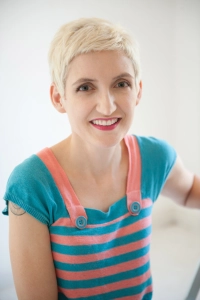My nine-year-old son believes that kissing got me pregnant.
Me: Do you know how we made you?
Waylon: You got that thing from Uncle Brian.
Me: Sperm?
Waylon: Yeah.
Me: And then? We used my egg, right?
Waylon: Yeah.
Me: So how are you related to Mommy?
Waylon: Well, I’ve been with her a lot. And also, when you two kissed [mimes sloppy French kissing] some of Mommy’s DNA got inside of you and then it got in me.
I love Waylon’s version of the story. Part of me wants it to remain exactly the same forever. But I also worry that we should be more strictly scientific about the mechanics of reproduction. I don’t want some playground smartypants to give him the 411.
I’ve written before about how hard it is to find children’s books about reproduction that don’t assume a gender binary (and children’s books about human sexuality that don’t assume reproduction). Most books for kids begin with “everyone is born a boy or a girl” and end with “some day you’ll make a family too,” but those are assumptions we don’t make in our family, because 1)we’re queer feminists and 2) Mommy is genderqueer.
 That’s why I was so excited about Cory Silverberg’s book What Makes a Baby. Silverberg, a Toronto-based sex educator and writer, set out to create a “where do babies come from” story that would be inclusive for transgender, gay, lesbian and other nontraditional families.
That’s why I was so excited about Cory Silverberg’s book What Makes a Baby. Silverberg, a Toronto-based sex educator and writer, set out to create a “where do babies come from” story that would be inclusive for transgender, gay, lesbian and other nontraditional families.
As an adult reader, I appreciate the book’s attempt to uncouple sex from gender. Playful gender-neutral figures are accompanied by matter-of-fact statements:
“Not all bodies have eggs in them. Some do, and some do not….Not all bodies have sperm in them. Some do, and some do not.”
I couldn’t wait to read What Makes a Baby with Waylon. He’s a little old for picture books, but I thought he would appreciate a story that was flexible enough to include our funky family.
When we finished, Waylon was thoughtful for a moment. “What did you think?” I asked.
“Is Uncle Brian kind of like my dad?”
Okaaaaay. Not what I was expecting. Maybe reproduction is a little too culturally overdetermined to be so easily unmoored from gender. Or maybe Waylon is more interested in the question “how did I, personally, arrive on this planet?” than in the general question of how babies are made. Still, it’s an important question, and one that we need to approach over and over again from multiple angles. I appreciate almost any occasion to start a safe and meaningful conversation.
While What Makes a Baby has broad appeal, I suspect it will be most helpful to families where two parents contributed biologically to making their child. I think it will be especially valuable in families where one or both parents’ gender presentation is different than the gender typically assigned to the role that they played in reproduction.
To continue to answer Waylon’s questions, I’ve ordered the COLAGE Donor Insemination Guide. I’ve also been talking up the idea that he’s Katy’s “brainchild,” because she contributed the single most essential ingredient in his conception: the idea to have a baby in the first place.
What Makes A Baby will be re-issued in 2013 by Seven Stories Press. Silverberg is currently working on two more books about sexuality for kids of various ages. Can’t wait!



January 9, 2013 at 8:19 pm
I hear they are planning books in this series for older kids, too. I thought they did pretty well with this one considering it’s a somewhat formidable task. It’s opened some good conversations in our house where we need to de-couple “egg” from “mom,” and also sperm didn’t come from their dad. I thought there was a nice amount of room for adoptive families as well (as the”sperm,” “egg,” and “place to grow” were not assumed to belong to parents), and the opening at the end about all the people waiting for you to be born — that’s a nice place to include non-genetic and/or non-gestational parents.
LikeLike
March 22, 2013 at 5:17 pm
I pre-ordered my copy, and I can’t wait for it to get here!
LikeLike
October 3, 2013 at 4:11 pm
Thank you for this! I’ve been looking for good books for my family and have been having a bit of trouble. We have an 8-year-old boy and are starting the adoption process for the next. We tried Heather Has Two Mommies, but it was a little… well I didn’t like it so much and haven’t read it to the kiddo yet. This one sounds great I will check it out.
Also, I love reading your blog. =)
LikeLike